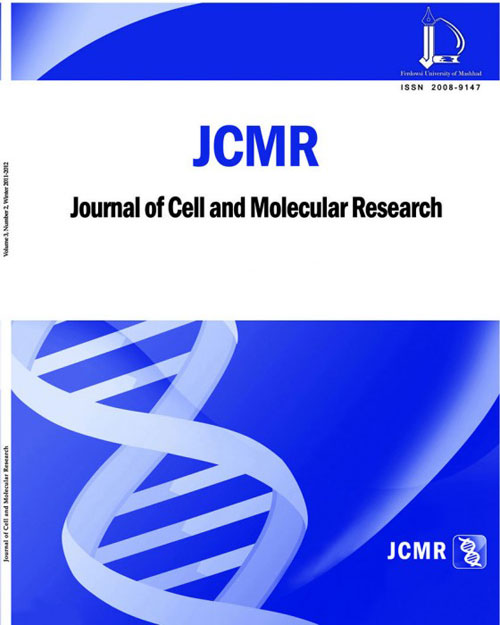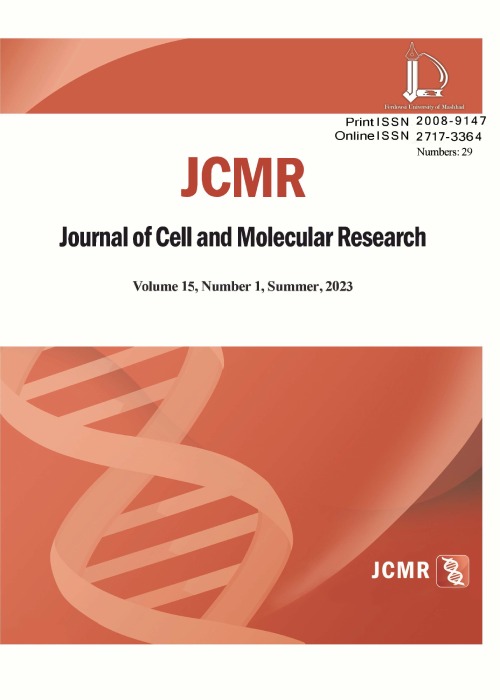فهرست مطالب

Journal of Cell and Molecular Research
Volume:7 Issue: 2, Winter and Spring 2015
- تاریخ انتشار: 1394/11/02
- تعداد عناوین: 10
-
-
Pages 68-69LncRNAs (long non-coding RNAs) are responsible to control the degradation process, RNA stability, orchestration, inhibition, transcription and histone modification etc. These RNAs have been termed as the key agents of several mechanisms such as development, organogenesis and regeneration of damaged tissues etc. They interact with a number of partner molecules either protein, RNAs or DNAs and control the cellular behaviour while differentiation or maintaining the stem cell status. This editorial is discussing the significance of lncRNAs as therapeutic target in stem cell therapy field.Keywords: LncRNAs, Regeneration, Molecular interactions, Stem cell fate, Differentiation
-
Pages 70-75Mesenchymal stem cells (MSCs) could differentiate into various types of tissues. These cells serve as a backup for the regeneration and repair of tissues or cells after injury. A skin wound is defined as an injury to the skin that needs to be restored. All types of cells in skin especially mesenchymal stem cells play important role in wound healing process. In particular, paracrine signaling of MSC regulates the cellular responses at the wound site leading to reduction of inflammation, stimulation of angiogenesis and induction of cell migration and proliferation. Because of these abilities, MSCs are one of the most common stem cells for cell therapy in wound healing. This review focuses on the role of MSCs on wound healing process. In addition, major phases of wound repair and challenges of cell therapy are discussed.Keywords: Mesenchymal Stem Cells, Wound healing, Inflammation, Angiogenesis
-
Pages 78-85Retinal pigment epithelium is responsible for maintaining the structural integrity of the retina by an efficient defense against free radicals, photo-oxidative exposure and light energy. For this purpose the main RPE line of defense is melanosomes. Melanin content of retinal pigment epithelium cells in adults and neonates reveals remarkable variations. In the current study we compared melanogenic factors gene expression levels in human adult and neonate RPE cells in culture. RPE cells from adult and neonate human eye globes were isolated and then cultured in DMEM: F12 (1:1) containing 10% FBS. Expression of RPE65 and Cytokeratin 8/18 markers in isolated cells was confirmed by immunocytochemistry. To evaluate the responsible factors in the pathway of melanin biosynthesis, gene expression of orthodenticle homeobox 2, microphthalmia-associated transcription factor A and H as prominent transcription factors, tyrosinase and dopachrome tautomerase as effective enzymes in the melanin biosynthetic pathway were examined in human neonate derived RPE cells compared to human adult derived RPE cells in culture. According to the Real-Time RT-PCR data, gene expression of MITF-H, OTX2, TYR and DCT in RPE cells of the neonates showed a significant increase compared to the adults. With increasing passage number, gene expression of MITF-H, OTX2, TYR and DCT showed remarkable decline. According to the role of OTX2 and MITF-H as the main transcription factor effectors on the TYR and DCT, restoration of OTX2 and MITF-H gene expression may be retain melanin content in RPE cells.Keywords: Human RPE cells, Melanogenic transcription factors, Enzymes
-
Pages 86-93The aim of this study was identification and characterization of highly efficient Extracellular Polymeric Substance (EPS) producing bacteria in activated sludge. Among 74 isolated bacteria, 20 EPS-producing bacteria were obtained from wastewater treatment plant of Bojnourd. EPS extraction was performed using absolute ethanol after glucose-enriched culture. Dry weight, concentration, and the ratio of carbohydrate to protein for the EPS of each isolate was then determined. Molecular identification of four bacteria with the highest EPS production was carried out using 16S rRNA gene amplification. The results showed that these bacteria are belonging to the genus Bacillus, Pseudomonas and Klebsiella. EPS productions were studied in different conditions (carbon and nitrogen sources, different levels of glucose and yeast extract and temperature) for the genus Bacillus and Pseudomonas.The production of EPS was observed highest while in the presence of 2.5 to 3% glucose and 0.5% yeast extract at temperature of 30 to 37°C.Keywords: EPS, producing bacteria, Sludge, 16S rRNA gene
-
Pages 94-101In the present study, some techniques were used for Soybean peroxidase (SBP) purification including: ammonium sulfate fractionation, DEAE Sephadex anion exchange chromatography and Concanavalin A Sepharose 4B affinity chromatography. Molecular weight of purified SBP was estimated about 44 kDa by SDS-PAGE as a single polypeptide band. The optimal pH and temperature for enzyme activity were found to be 4. 5 and 70◦C, respectively. The enzyme was more stable in alkaline pH than acidic ones and could tolerate 10 minutes heating in 40-50◦C without any loss of its activity. Both NaCl and KCl were found to have significant effects on the enzyme stability, but presence of NaCl was more effective than KCl. Our results showed that after 24 hours incubation of the enzyme in the presence of 20 mM NaCl, more than 60٪ of the enzyme activity was remained while it would fall to 3٪ if incubation was not accompanied by NaCl. Purified peroxidase from seed hull of soybean relative to the other identified peroxidases was more stable, for this reason a lot of benefit will be considered by use of this enzyme in different industry.Keywords: Enzyme stability, Glycine max, Peroxidase, Purification, Soybean
-
Pages 102-107Studies on the genes contributing to the seed filling in chickpea and its protein content might be valuable in engineering plants with seeds of a higher nutritional value. A gene of interest is phosphoenolpyruvate carboxykinase (pepck), encoding a protein with a substantial role in the gluconeogenesis pathway. In the present study, the protein content (percentage) was measured in a number of cultivated chickpea genotypes, followed by comparison of the expression levels of pepck gene at different stages of seed filling in some of the genotypes. This study aims at revealing the relation between pepck transcript level with protein content of chickpea seeds which might, in the longer term, end at protein quality improvement of the crop through the gene manipulation procedures. The results which were verified by Real Time-PCR and Western blot techniques in four genotypes of plant, showed that, the amount of pepck expression was significantly higher at the stage of seed fillingthan at other stages in all of genotypes and the lowest levels of expression belonged to flowering and seed formation and the PEPCK protein level was higher in the high protein genotypes compared to the low protein genotypes.Keywords: Chickpea, Nitrogen metabolism, Phosphoenolpyruvate carboxykinase, Real, time PCR, Western blot
-
Warning of Reducing Genetic Diversity of Abramis brama (Berg, 1905) in Gilan Coast Using SSR MarkersPages 108-114Genetic diversity is one of the three levels of biodiversity. The aim of present study was to compare levels of genetic polymorphism between wild Bream populations using seven microsatellite loci. Genetic diversity was investigated by studying samples collected from two regions, the coast of Chamkhale and Bandaranzali of Gilan province. A total of seven microsatellite loci (MFW7, MFW26, Mcs1EH, Rser10, Bl1-153, Bl2-114 and IC654) were used. The average number of alleles in Chamkhale and Bandaranzali coast were 10 and 10.71 alleles, respectively. The numbers of effective alleles were 7.05 and 7.74 alleles in each population. Allele frequency was declined in wild fish due to inbreeding and genetic drift. The mean of observed heterozygosity values were 0.66 and 0.70 in Chamkhale and Bandaranzali coast, respectively. Approximately, all of loci showed deviation from Hardy-Weinberg equilibrium. The genetic similarity and distance between the two populations were 0.316 and 0.684, respectively. The results of Molecular Variance Analysis revealed that genetic diversity within locations was 97 percent, while among them was 3 percent. The Fst value was 0.024 that indicates the low genetic differentiation between the two locations which could be explained by the low number of alleles in two populations. Furthermore, the Natural Migration (Nm) between two stations was obtained 16.30. According to the analysis, it seems that Abramis brama has not a desirable genetic diversity in the investigated regions.Keywords: Bream (Abramis brama orientalis), Microsatellite, Genetic diversity, Polymorphism
-
Pages 115-132The biogeography of genus Linaria was revealed by the available chromosome counts from all over the world. Chromosome numbers of 92 taxa of the genus Linaria are included in an on-line karyological database. Furthermore, information about chromosome numbers taken from 374 literature sources was used in this paper. Each database record includes name of taxon, data on chromosome and data on the origin of the material and species-area distribution. Each database also provides a reported chromosome number and place of publication. More than half of the available species in chromosome data are diploid or consist of both diploid and polyploid populations and a few numbers of the species are polyploid. For the first time, in this study, mitosis and meiosis chromosome numbers of 13 populations belonging to three species, namely L. lineolata Boiss (2n = 2x = 12), L. fastigiata Chav. (2n = 2x = 12) and L. dalmatica (L.) Mill. (2n = 2x = 12), were determined by examining anthers. In addition, pollen stainability has been documented in Linaria populations in Iran.Keywords: Chromosome numbers, Karyological database, Linaria, Pollen stainability, Polyploidy, Scrophulariaceae
-
Pages 133-142Cytotaxonomy is a branch of cytogenetics, devoted to the comparative study of karyological features for systematic and evolutionary purposes. Surely, awareness of chromosomal characters increases our knowledge in different fields of studies. In this study, cytogenetic analyses were performed in 92 Mus musculus specimens from 26 localities in Iran. Cytogenetic characteristics of the house mouse, Mus musculus, in Iran show that the chromosome number is 2n=40 and the arm number is NF=40. The karyotyping results indicated the presence of 20 Acrocentric (A) chromosome pairs. The L/S (r ratio) was between 2.0621 and 4.5862. The length of shortest chromosome, length of longest chromosome and mean of chromosomal length in different populations were between 2-3.58, 6.07-7.01 and 3.43-5.05 (μm), respectively. The results showed two distinct karyotypic formulae, namely cytotype B and cytotype C. Asymmetry indexes (AI, DI, As%, A, A2, A1 and Syi%) in all population except Birjand and Khash showed symmetry in chromosomes. In clustering methods using the matrix of symmetrical indexes similarities, four clusters were revealed, one for specimens of central and east of Iran, the second cluster for specimens from south and west of Iran, the third cluster was related to the eight specimens of Birjand and finally, the fourth cluster for two specimens of Khash localityKeywords: Cytotaxonomy, Systematic, Chromosome structure, House mouse, Karyology, Iran, Middle East
-
Pages 143-144Understanding the molecular mechanisms in regeneration could help the stem cell therapists to improve the clinical practices and could be considered a major milestone in the translation of stem cell research to clinics. Chemokines have been described as one of the most significant singling networks in stem cells homing and regeneration of damaged organs. CXCR4/CXCL12 has been known as a key player in this regard. Expression of CXCR4 has been observed in a number of cells such as mesenchymal stem cells, epithelial cells etc and plays crucial and unique role in the migration of cells towards a cytokine gradient and regulating stem cells trafficking as well as tissue/organ regeneration and embryogenesis.Keywords: Chemokine, CXCR4, Stem cell therapy, Regenerative Medicine


